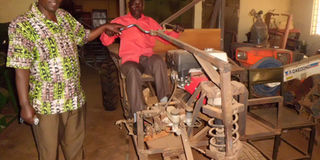Prime
Homemade tractors to boost your farm

Scientists at Kabanyolo demonstrate how the tractor operates. MV Mulimi has been engineered to perform several functions aside from the standard ploughing and transporting of crops. Photo by Lominda Afedraru.
What you need to know:
- The first prototype was named Kabanyolo 1 and the team kept on improving on the other two consequent models named Kabanyolo 2 and 3, writes Lominda Afedraru
Scientists at Makerere School of Agriculture and Environmental Sciences have over the years engaged in manufacturing portable tractors for various farm operations ranging from ploughing, weeding, showing seed to harvesting among others.
This was revealed by scientists majoring in Agricultural Science and Engineering at Makerere University Agricultural Research Institute Kabanyolo (MUARIK) recently.
Prof Noble Banadda, currently engaged in skilling students in the area of bio engineering at the Institute, explained to Seeds of Gold that the first locally made tractors at the Institute was done in 1955 by visiting researchers from developing countries and scientists working at Makerere University.
Kabanyolo model
The first prototype was named Kabanyolo 1 and the team kept on improving the other two consequent models named Kabanyolo 2 and 3.
This was to ensure that students pursuing courses in agriculture engineering learn how to operate and drive a tractor on farm.
John Tumwijukye, from department of technology, irrigation and engineering at MUARIK explains that the tractors were manufactured with the main aim of training students on farm and they were always taken on farm for operational work.
The models were later fabricated and sold to farmers not only in Uganda but across East Africa.
They were fabricated and assembled by scientists of Makerere with colleagues from developing countries including visiting scientists from United Kingdom. The first model lacked a number of features such as comfortable seats for the driver and the operating gear was not well fabricated but the second and third models had most of the required parts.
Improved models
Today scientists have improved these models to a multi-purpose MV Mulimi which were developed and become operational in 2016 by a team of scientists from CAES with Prof Banadda as the principal investigator.
According to Dr Nicholas Kiggundu, from CAES who was part of the development team, the tractor design is the ultimate value addition as it attempts to solve farmers’ problems at the grass roots. The purpose of developing the tractor follows a demonstrated need for low cost technologies in farm fields and postharvest handling operations.
“The MV Mulimi costs Shs30m to develop as its optimal cost; including all the elements required to carry out the tasks. Its cost in the open market once it is in production is about Shs19m,” he said.
Components
According to Tumwijukye, MV Mulimi contains components for ploughing, sowing seed, weeding, harvesting and pumping water for irrigation. Farmers can use it for charging phones and many other uses.
It is made using locally available engineering materials in the country meaning it can easily be repaired in case of any break down.
It is the contention of the scientists that in the near future they will be in position to develop a horse tractor with modern features.
Functions
The tractor can pump water from depths of up to seven metres to a radius of 33 metres, it can thresh half a tonne of maize in an eight-hour shift and its wheelbase allows it to carry up to two tonnes of produce.




